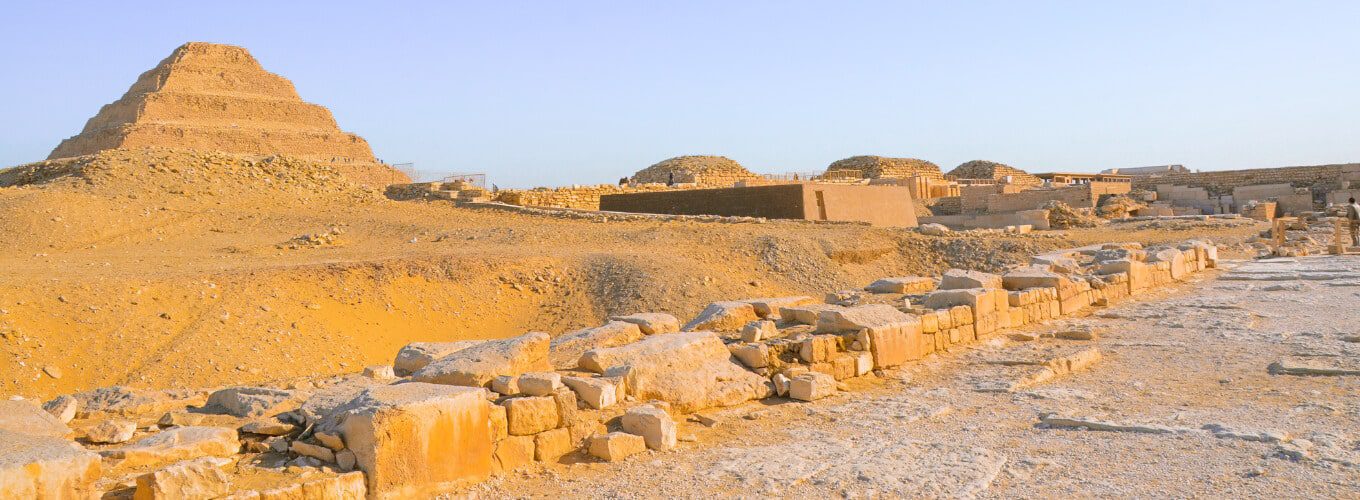The Step Pyramid of Djoser stands tall in the Saqqara necropolis near Cairo. It shows the genius of ancient Egypt’s architecture. But what secrets does it hold, and how did it lead to the famous pyramids of Giza? Exploring this ancient wonder could reveal the amazing feats of the Old Kingdom.
Built in the 27th century BCE, the Step Pyramid is a giant among ancient structures. It has six stacked mastabas, getting smaller as they go up. This makes it almost 60 meters tall, a giant for its time. The inside is made of limestone, and the outside is covered in white Tura limestone, looking very striking.
Key Takeaways
- The Step Pyramid of Djoser is one of the earliest and most impressive stone structures in the world, built during the 27th century BCE.
- The pyramid stands at a height of almost 60 meters, making it one of the tallest buildings of its period.
- The Step Pyramid features a unique architectural design with six stacked mastabas, each diminishing in size as it ascends.
- The core of the pyramid is constructed from limestone blocks, while the outer layers are adorned with fine white Tura limestone.
- The Step Pyramid of Djoser is located in the Saqqara necropolis, a treasure trove of ancient Egyptian monuments and tombs.
Journey Through Time: Unveiling the Ancient Wonders
Step into Egypt’s architectural past and start a journey to Saqqara. This place is full of treasures. The Step Pyramid of Djoser shows the skill of ancient Egyptian builders.
The Saqqara Complex: A Treasure Trove of Ancient Wonders
Saqqara is more than just one monument. It’s a big area filled with many old buildings. Each one adds to Egypt’s history. You’ll find tombs, temples, pyramids, and more.
The Step Pyramid of Djoser is the main attraction. Built in the 27th century BC, it was made for Pharaoh Djoser. It’s a key example of the Old Kingdom’s creativity, leading to the Giza pyramids.
Preserving the Past for Future Generations
The Saqqara necropolis and the Step Pyramid have lasted over 4,600 years. They amaze people all over the world. That’s why they’re UNESCO World Heritage Sites, protected for the future.
Thanks to places like SchoolTube, Saqqara, and the Step Pyramid, teach us about ancient Egypt. They inspire young people to learn about this amazing history and site.
Historical Context: Pharaoh Djoser and the Birth of Pyramids
Pharaoh Djoser was the third ruler of ancient Egypt’s Third Dynasty. He lived during a time when the idea of a pyramid tomb was new. Before him, pharaohs were buried in mastaba tombs, which were flat-roofed and made of mudbrick.
Djoser wanted a grander tomb for himself. This led to the creation of the Step Pyramid. It was a big change in how pharaohs were buried.
Djoser ruled around 2670 BCE. During his time, the Step Pyramid was built. It was the tallest structure around, standing at 205 feet. The pyramid complex was huge, covering 40 acres and having a high wall and a big trench.
- Djoser was the first king of the Third Dynasty of Egypt. He used stone for buildings instead of mudbrick.
- The Step Pyramid took about 20 years to build, from 2670 BCE to 2650 BCE.
- The pyramid complex was huge, with a high wall and a big trench. It had 13 false doors.
The Step Pyramid went through many changes as it was built. It started as a mastaba and turned into a pyramid. This was a big step in ancient Egyptian architecture. It led to the famous Giza pyramids later on.
“The Step Pyramid of Djoser, designed by Imhotep, was constructed to a height of 204 feet (62 meters), making it the tallest structure of its time.”

Design and Construction: A Revolutionary Architectural Feat
The Step Pyramid of King Djoser in Saqqara, Egypt, was a big deal back then. It changed how ancient Egyptians built things. Imhotep, the chief architect, made it happen.
This pyramid looks like steps stacked on each other. It has six layers. The inside was built with Tura limestone blocks. The outside was covered in polished white Tura limestone, making it look amazing.
Materials and Techniques Used in Building the Step Pyramid
Building the Step Pyramid was a huge engineering task. The ancient Egyptians moved 25 million tons of stone in less than 150 years. That’s a lot of work!
- Each big stone weighed about 300 kilograms.
- Later pyramids had way heavier stones, over 2.5 tons each.
- They used a special system with underground tunnels and a deep well to move stones.
- This system shows that ancient Egyptians were smarter than we thought.
The Step Pyramid is about 4,500 years old. It’s the oldest of the seven big pyramids in Egypt. Imhotep, the chief architect, helped design it. His work led to even bigger pyramids later on.
| Construction Metric | Djoser’s Step Pyramid | Chephren’s Pyramid |
| Average Stone Weight | ≈300 kg | >2.5 tons |
| Total Stones Raised | 25 million tons | 25 million tons |
| Construction Timeline | Less than 150 years | Less than 150 years |
The Step Pyramid of King Djoser: A Glimpse into the Past
The Step Pyramid of King Djoser is in the Saqqara complex. It shows the amazing skills and faith of ancient Egypt. Built about 4,700 years ago, it takes us back in time. It shows us the great work of Pharaoh Djoser and his team.
The Step Pyramid is huge, covering 15 hectares. It has a wall made of Tura limestone that is 10.5 meters tall. The pyramid itself is 62 meters high, with six steps. This design was different from the Great Pyramid of Khufu.
Underground, the complex has many features. There’s a mortuary temple, a serdab, and a big burial chamber. It was more than just a tomb. It showed Djoser’s journey to the afterlife, linking him to the gods and the heavens.
| Key Architectural Features | Dimensions |
| Rectangular site of Saqqara | 544 by 277 meters |
| Burial shaft depth | 28 meters |
| Granite plug sealing the burial chamber | 2 meters thick, 3.5 tons |
| Number of gates along the exterior | 15, with the 15th as the only entrance |
| Initial and final number of steps | 4 to 6, raising the height to 60 meters |
| Height of the Step Pyramid | 62 meters (203 feet) |
The Step Pyramid is known for its unique design and deep meaning. Scholars and visitors find it fascinating. It shows us the creativity and beliefs of the ancient Egyptians.
Significance: Paving the Way for Giza’s Grandeur
The Step Pyramid of King Djoser is a key part of ancient Egyptian architecture’s growth. It was a big step from the old mastaba tombs to the huge pyramids that would change the Giza skyline. Djoser’s bold idea led to the Giza pyramids, starting a new time of greatness in building.
Symbolism and Religious Rituals Surrounding the Step Pyramid
The Step Pyramid was more than a big building; it was filled with deep meaning. It showed Djoser’s special link to the gods through its design, which matched the universe’s directions. The pyramid became a place for big religious events and offerings, linking the pharaoh to the gods even after Djoser was gone.
- The Step Pyramid’s design showed Djoser’s connection to the heavens and gods, pointing to his role as a bridge between humans and gods.
- At the Step Pyramid, there were special religious events and offerings. This made it a sacred place and showed Djoser’s lasting impact.
- The Step Pyramid’s move from mastaba tombs to the big Giza pyramids started a new chapter in ancient Egyptian architecture.
The Step Pyramid of King Djoser is a key moment in ancient Egyptian architecture and spirituality. Its deep meaning and religious importance led to the Giza pyramids. This made Djoser a visionary who started a new time of greatness and respect for the divine.
Exploring the Saqqara Complex: A Necropolis of Wonders
The Saqqara necropolis is in the heart of Egypt. It shows the greatness of ancient Egyptian civilization. Visitors feel like they’ve traveled back in time. They see ancient tombs, temples, and amazing buildings that tell us about the ancient Egyptians’ lives and beliefs.
The Step Pyramid of King Djoser is the highlight of Saqqara. Built between 2630 and 2611 BCE, it’s the oldest stone building in the world. It was the first stone structure in Egypt. Underneath it, there are three miles of tunnels and rooms, adding to its mystery.

But there’s more to Saqqara than the Step Pyramid. The site is huge, covering 7 by 1.5 km. Visitors can see many pyramids, tombs, and temples. The tomb of Kagemni, a relative of King Teti, is especially interesting. It shows the skill and care in ancient Egyptian funerals.
Saqqara shows the ancient Egyptians’ amazing engineering and beliefs. It has catacombs full of mummified ibises, which were offerings to Imhotep. This shows how sacred this place was to the ancient Egyptians.
Visiting Saqqara is like stepping out of time. It lets visitors dive deep into ancient Egypt’s history and culture. With tickets at 150 Egyptian pounds, it’s a top spot for anyone wanting to explore the past.
| Saqqara Necropolis Key Facts | Details |
| Admission Cost | 150 Egyptian pounds per person (approx. $9) |
| Construction of the Step Pyramid | 2630 – 2611 BCE |
| Step Pyramid Height | 200 feet |
| Passageways and Chambers | 3 miles carved beneath the Step Pyramid |
| Architectural Significance | The first complex built entirely of stone in Egypt |
| Saqqara Site Area | Approximately 7 by 1.5 km |
Visitors to Saqqara step back into a time when ancient Egyptians led in architecture and culture. From the grand Step Pyramid to the detailed tombs and temples, it’s a peek into the past. It invites visitors to learn about one of the world’s most intriguing civilizations.
Restoration Efforts: Preserving a Timeless Legacy
The Step Pyramid of King Djoser is over 4,700 years old. It was built in the 27th century BCE. This amazing structure, 204 feet tall, has amazed people for centuries. But, it has faced many problems, like erosion, earthquakes, and theft.
In the 20th century, people worked hard to save this wonder. They fixed the structure, repaired stones, and made it look new again. This was a tough job because the pyramid was old and fragile.
Challenges Faced in Restoring the Step Pyramid
Fixing the Step Pyramid was a big task. It was old, worn out, and had weak spots. The team had to be very careful with every step.
They also had to deal with big problems like earthquakes. A 5.8-magnitude quake in 1992 hurt the pyramid a lot. So, they worked for 14 years to fix it and keep it safe.
Thanks to their hard work, the Step Pyramid looks great again. It’s now a UNESCO World Heritage Site. People from all over come to see its beauty.
Visiting the Step Pyramid: An Awe-Inspiring Experience
Today, visitors can see the amazing Step Pyramid complex at Saqqara. It shows the smart building skills of ancient Egyptians. The inside of the pyramid is mostly closed to tourists. But the big courtyard, the mortuary temple, and the areas around give a peek into Pharaoh Djoser’s world.
The Step Pyramid is a UNESCO World Heritage Site. It’s one of the oldest stone buildings in the world, from around 2630 BCE. Designed by Imhotep, it was a big step in ancient Egyptian architecture. It led to the building of the Pyramids of Giza.
Visitors feel like they’ve stepped back in time. They see the lasting impact of Pharaoh Djoser and Imhotep’s genius. This place shows the deep history of ancient Egypt.
The Saqqara Necropolis has many tombs and monuments from the Old Kingdom Pharaohs. The Step Pyramid complex has underground chambers and a special stepped design. It lets visitors dive into the sacred rituals and beliefs of ancient Egypt.
Read our related articles:


